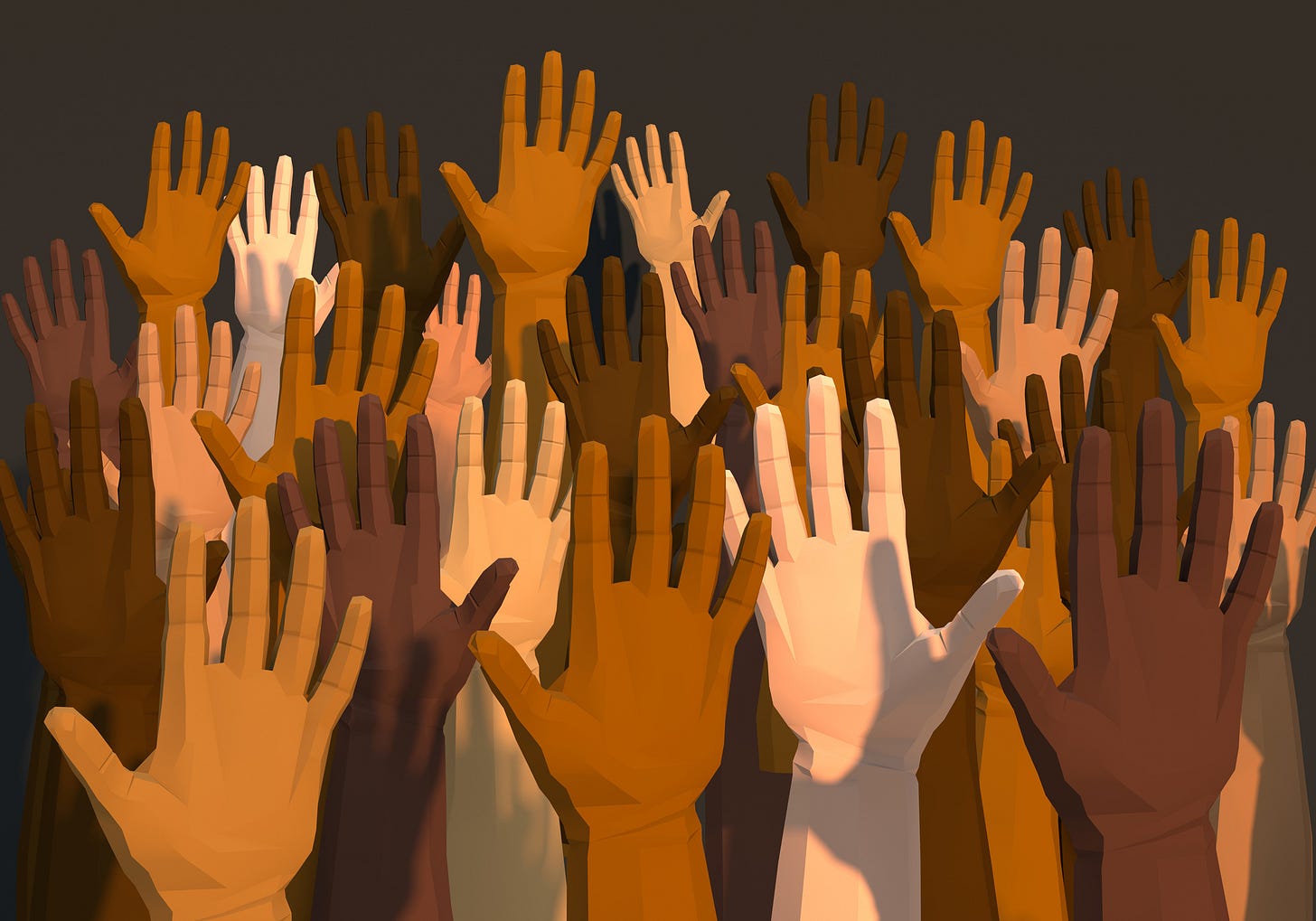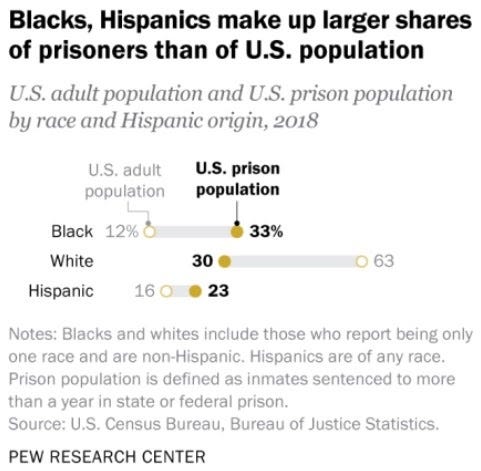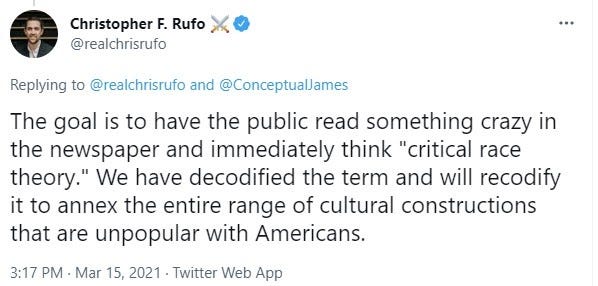1 truth and 3 lies about Critical Race Theory
Between now and November 2022, you will be hearing a lot about Critical Race Theory (CRT). On Saturday night, former President Trump bashed CRT during his first rally since leaving the White House. Last week, Senator Ted Cruz (R-TX) introduced the "END CRT Act." In the first two weeks of June, CRT was mentioned 408 times on Fox News.
Why has a complex academic legal framework that has been around since the 1980s suddenly become a hot political topic? We don't have to speculate. Right-wing operatives have stated publicly that they plan to use CRT to elect more Republicans.
Steve Bannon, who advised Trump in the White House and now hosts an influential podcast on the right, said putting CRT at the center of the political discussion was the key to Republican success in 2022 and beyond:
I look at this and say, "Hey, this is how we are going to win." I see 50 [House Republican] seats in 2022. Keep this up. I think you’re going to see a lot more emphasis from Trump on [CRT] and [Florida Governor Ron] DeSantis and others. People who are serious in 2024 and beyond are going to focus on it.
Trump, Cruz, Bannon, and many other Republicans say that CRT is an insidious force that is being imposed in schools, corporations, and the government. This is how Cruz describes CRT in his new bill.
By teaching that certain individuals, by virtue of inherent characteristics, are inherently flawed, critical race theory contradicts the basic principle upon which the United States was founded that all men and women are created equal.
This is a false description of CRT. (It is also an inaccurate historical description of the Declaration of Independence, which states "all men are created equal." And it was referring only to white men.)
But understanding politics in the months ahead will require understanding the truth about CRT — and how CRT is being distorted and manipulated.
The truth about Critical Race Theory
At its heart, Critical Race Theory emerged from a group of legal scholars trying to answer a question: Why, after the Civil Rights Act of 1964 created formal legal equality between racial groups, does substantive racial inequality persist?
Let's explore how this works with a concrete example. The United States has the largest prison population in the world. But Black Americans are incarcerated at far greater rates than whites. As of 2018, the latest data available, Blacks represented 12% of the general population and 33% of the prison population. Conversely, whites represent 63% of the general population and 30% of the prison population.
Why is there such a stark disparity? One explanation could be that Black Americans commit more crime. The data, however, does not fully support such a conclusion. About a quarter of the prison population is serving time for drug crimes and "[b]lack and white Americans sell and use drugs at similar rates." Nevertheless, Blacks are 2.7 times more likely to be arrested, and more than 6 times more likely to be incarcerated, for drug-related offenses than whites.
CRT scholars look at these statistics as evidence of structural racism. Specifically, they seek to identify "laws, policies, and procedures that function to produce racial inequality." In her book, Critical Race Theory: A Primer, Berkeley Law Professor Khiara Bridges details the characteristics of structural racism:
1. Lack of intentionality. Structurally racist laws "do not have racial subordination as their purpose or design."
2. Banality. "[T]he practices that sustain racial inequality are not spectacular… they are daily, prosaic, mundane, ordinary."
3. Race neutrality. Laws and procedures "reproduce racial hierarchy without mentioning race at all."
CRT scholars examine the complex ways that the law creates racial inequality through structural racism. For example, the 1996 Supreme Court case of Whren v. United States helps explain how Black Americans are disproportionately arrested and incarcerated for drug crimes. In that case, Michael Whren and his friend, James Brown, were driving when a police officer got a "feeling" that they were engaged in drug-related activity.
Under the Fourth Amendment to the Constitution and Supreme Court precedent, however, a police officer cannot stop or search someone based on a "feeling." Depending on the circumstances, the officer would need "probable cause" or "reasonable suspicion" to stop and search the car. So the officers followed the car until they observed it make a turn without signaling. When they pulled over the vehicle, they saw a bag of crack cocaine on Whren's lap and arrested Whren and Brown.
A unanimous Supreme Court found the stop and the arrest was legal. CRT scholars note that the ruling effectively allows police to stop any car. If a police officer follows any driver for long enough, they will observe some minor traffic violation, providing a pretext for a stop. Since many people, including police officers, have implicit or explicit biases about the activities of young black men and other minority groups, they will be stopped at higher rates. In this way, a mundane, racially neutral Supreme Court decision helps explain racial inequality in incarceration rates.
The purpose of CRT is to understand the structural causes of racial inequality — large and small — in order to dismantle them and create a fairer society. CRT scholars use similar analysis to explain how the law creates racial inequality in health, education, and other areas.
Disagreeing with some or all of CRT does not make you a racist. CRT is a lively field of academic study and many CRT scholars disagree with each other.
But Chris Rufo, an operative affiliated with the Manhattan Institute who popularized opposition to CRT through frequent appearances on Fox News, acknowledged in March that he is simply using CRT as a vessel to fill with whatever concepts he thinks are politically unpopular.
By their own admission, the current crop of CRT critics is not engaged in a good faith argument. They are misrepresenting and distorting CRT for political purposes.
Lie #1: CRT is being taught in K-12 schools
Anyone with a basic understanding of CRT understands that it is not being taught in K-12 schools. The reason is simple: The concepts underlying CRT are generally beyond the scope of undergraduate education, much less elementary school students. A website set up by CRT critics to document "the negative impact Critical Race Training has on education" does not even cover K-12 curriculum because it's "more difficult to track."
Nevertheless, "[l]egislators in at least 15 states have introduced measures this session that would prohibit the teaching of critical race theory or related concepts in all publicly funded schools." These bills have been introduced even though there is "no evidence that [CRT] is being taught in any public school."
As Matt Gertz notes, there are "are more than 130,000 K-12 schools in the United States." As a result, "it is inevitable that some of them will make decisions that are clumsy, ineffective, unpopular, or all of the above" — especially as they seek to answer students' questions about police shootings, racial justice protests, and other aspects of the modern world. This provides plenty of fodder for Fox News but does not mean that CRT is being taught in schools.
Lie #2: CRT is about making white people feel guilty
Some critics of CRT acknowledge that CRT itself is not being taught in schools but students are being taught concepts derived from CRT. Pundit Andrew Sullivan, for example, says that students are being taught "a whole new epistemology that is directly downstream of academic critical theory." For example, Sullivan claims, schools are teaching "white kids to internalize their complicity in evil."
It is possible that, of the millions of white students, someone has been taught that being white makes them "complicit with evil." But this is not CRT.
CRT, by contrast, is about how structures — not individuals — create racial inequality and injustice. "According to most definitions of institutional racism, actors — be they good, bad, or indifferent — are irrelevant in the grand scheme of things, as they play a minuscule role in something much bigger than themselves," Bridges explains, "Undeniably, individuals animate these institutions. But the fault lies not with the individual actors who bring institutions to life."
CRT is not about making white people feel guilty. It's an argument that racial inequality is the product of something bigger than discrete individual action.
Lie #3: CRT is about defining people based on their race
Cruz's bill asserts that CRT stands for the idea that white people are "inherently flawed." This isn't true. CRT scholars, in fact, believe that race is a social construct and not a biological entity. They believe there is nothing "natural" about racial categories and, therefore, nothing "inherently" flawed or good about being a white person or Black person. They are artificial categories that society constructed.
As a result, CRT scholars reject the idea that inequalities between races can be explained through genetics. (This view is also supported by the Human Genome Project, which found that 99.9% of all human's genetics are the same and the small differences are not distributed along racial lines.) But CRT scholars also reject the idea that you can fix these inequalities by ignoring race.
Rather, CRT scholars believe the racial hierarchy has to be acknowledged in order to be dismantled. Chief Justice Roberts famously wrote that the "way to stop discrimination on the basis of race is to stop discriminating on the basis of race." CRT scholars, according to Bridges, believe there is a difference "between thinking about race in order to maintain the dominance of a racial group and thinking about race in order to empower a subordinated racial group."
CRT embraces "race consciousness in the service of racial justice." But, CRT teaches, we should be aware of racial inequality not because people of different races are inherently different, but because they are the same.





Yet again, the GOP has conducted a master class in the politics of FEAR. Fear is one of the most powerful motivating factors in politics that I've seen in my lifetime. Those who vote to PREVENT something are much more passionate and stay 'on point' with greater frequency than those who espouse a supposedly beneficial thing. You can see it in even in the 1/6 insurrection - those mostly white people desperately wanted to overturn the results of the election because they're deathly afraid that they will become minorities in this country. They are TERRIFIED of losing their supremacy. DJT gave them the hope that he would suppress the minorities to the point where whites would remain the dominant 'race' regardless of numbers.
I'm not sure how one goes about motivating large numbers of people without using the same tactics, however. Even now, our greatest message to combat the lies regarding CRT is that the GOP will make our lives even more miserable if they're allowed to continue to demonize CRT. And that holds true in other areas as well... especially given the voter suppression tactics playing out across the nation.
Nicely articulated. Thank you